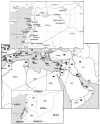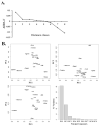Geographical structure of the Y-chromosomal genetic landscape of the Levant: a coastal-inland contrast
- PMID: 19686289
- PMCID: PMC3312577
- DOI: 10.1111/j.1469-1809.2009.00538.x
Geographical structure of the Y-chromosomal genetic landscape of the Levant: a coastal-inland contrast
Abstract
We have examined the male-specific phylogeography of the Levant and its surroundings by analyzing Y-chromosomal haplogroup distributions using 5874 samples (885 new) from 23 countries. The diversity within some of these haplogroups was also examined. The Levantine populations showed clustering in SNP and STR analyses when considered against a broad Middle-East and North African background. However, we also found a coastal-inland, east-west pattern of diversity and frequency distribution in several haplogroups within the small region of the Levant. Since estimates of effective population size are similar in the two regions, this strong pattern is likely to have arisen mainly from differential migrations, with different lineages introduced from the east and west.
Figures






References
-
- Adams SM, Bosch E, Balaresque PL, Ballereau SJ, Lee AC, Arroyo E, Lopez-Parra AM, Aler M, Grifo MS, Brion M, Carracedo A, Lavinha J, Martinez-Jarreta B, Quintana-Murci L, Picornell A, Ramon M, Skorecki K, Behar DM, Calafell F, Jobling MA. The genetic legacy of religious diversity and intolerance: paternal lineages of Christians, Jews, and Muslims in the Iberian Peninsula. Am J Hum Genet. 2008;83:725–36. - PMC - PubMed
-
- Akarli ED. The Long Peace: Ottoman Lebanon, 1861-1920. I.B. Tauris; London: 1993.
-
- Al-Zahery N, Semino O, Benuzzi G, Magri C, Passarino G, Torroni A, Santachiara-Benerecetti AS. Y-chromosome and mtDNA polymorphisms in Iraq, a crossroad of the early human dispersal and of post-Neolithic migrations. Mol Phylogenet Evol. 2003;28:458–72. - PubMed
-
- Aubet M-E. The Phoenicians and the West: Politics, Colonies and Trade. Cambridge University Press; Cambridge: 1993.
Publication types
MeSH terms
Grants and funding
LinkOut - more resources
Full Text Sources

